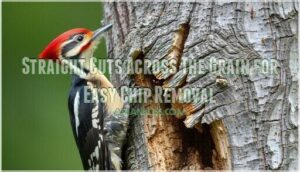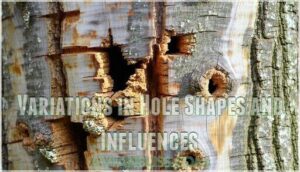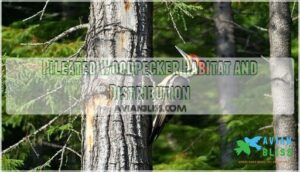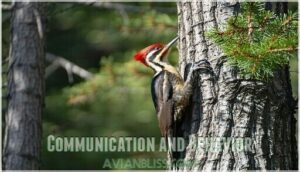This site is supported by our readers. We may earn a commission, at no cost to you, if you purchase through links.
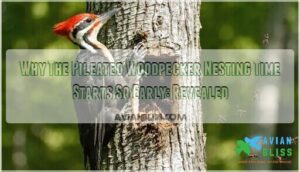
Early nesting aligns perfectly with emerging carpenter ants and wood-boring beetles—their favorite protein sources for growing chicks. By starting before peak predator activity ramps up in late spring, they optimize their breeding success while minimizing energy expenditure.
This strategic timing guarantees their young develop during the forest’s quietest period, giving them the best shot at survival in an increasingly competitive woodland neighborhood.
Table Of Contents
- Key Takeaways
- Pileated Woodpecker Nesting Timeline
- Wood Anatomy and Chip Removal
- The Square Hole Hypothesis
- Variations in Hole Shapes and Influences
- Pileated Woodpecker Habitat and Distribution
- Nesting and Breeding Habits
- Communication and Behavior
- Diet and Ecological Role
- Frequently Asked Questions (FAQs)
- What time of year do pileated woodpeckers nest?
- How long do baby pileated woodpeckers stay with their parents?
- How do you stop woodpeckers from nesting?
- Do pileated woodpeckers return to the same nest?
- What is the average lifespan of a Pileated Woodpecker?
- Can Pileated Woodpeckers be pets?
- How do Pileated Woodpeckers protect themselves from predators?
- What is the significance of the Pileated Woodpeckers red crest?
- Can Pileated Woodpeckers be found in urban areas?
- Do pileated woodpeckers migrate before nesting season?
- Conclusion
Key Takeaways
- You’ll secure prime nesting territories by starting in February – Early excavation beats competition from other cavity-nesting species for the best dead trees and locations.
- You’ll synchronize breeding with peak insect availability – Carpenter ants and wood-boring beetles emerge in late winter/early spring, providing essential protein for growing chicks.
- You’ll avoid predators through strategic timing – Starting before snakes, raccoons, and other nest raiders hit peak activity in late spring dramatically improves chick survival rates.
- You’ll conserve energy during the forest’s quietest period – Early nesting occurs when environmental conditions are most favorable and competition is minimal, reducing stress on breeding pairs.
Pileated Woodpecker Nesting Timeline
You’ll notice pileated woodpeckers start their nesting activities as early as February, giving them a significant head start over most other bird species. This early timing isn’t random—it’s a carefully evolved strategy that enhances their breeding success by aligning with peak insect availability and avoiding later predator activity.
Why Early Nesting is Crucial
Understanding why pileated woodpeckers begin their nesting season so early reveals three critical survival strategies that give these impressive birds their competitive edge.
Food Abundance drives the timing perfectly. By starting in late winter, you’re synchronizing with peak insect activity when carpenter ants and wood-boring beetles emerge. This food availability guarantees your hatchlings access maximum protein during their most vulnerable growth period.
Predator avoidance becomes your secret weapon through strategic timing. Early nesting behavior means your eggs and chicks develop before snakes, raccoons, and other predators hit peak activity in late spring and summer. You’re basically beating the rush of hungry threats.
Breeding success improves dramatically when you claim prime real estate first. Here’s what early nesting secures:
- Territory establishment in mature forests with ideal snag trees
- Reduced competition from other cavity-nesting species
- Climate adaptation advantages during moderate spring temperatures
This competitive edge through early nesting time starts translates directly into higher fledgling survival rates and long-term reproductive success across the nesting season.
Energy Conservation Strategies
Pileated woodpeckers master energy conservation through smart pecking efficiency and foraging optimization. They target carpenter ant colonies in dead wood, maximizing calories per energy spent. Cavity insulation provides thermal regulation, reducing metabolic rate during cold nights.
Their early nesting timing aligns with peak food availability, ensuring chicks get maximum nutrition while parents minimize energy expenditure during the demanding breeding season. They also rely on winter foraging strategies to survive.
Physical Limitations and Pecking Abilities
While energy conservation matters, physical limitations largely determine when pileated woodpecker nesting time starts each year. These impressive birds face real constraints that affect their pecking abilities and breeding success.
Bill Morphology determines excavation efficiency. Their chisel-like bills measure 2-3 inches long, perfectly designed for wood removal. Skull Structure features reinforced bone density around the brain, preventing injury during thousands of daily impacts.
Pecking Force reaches extraordinary levels—up to 1,200–1,500 times gravitational force per strike. However, Muscle Strength in their neck and shoulders requires peak condition for sustained excavation work. Impact Absorption systems protect their brain through specialized shock-absorbing tissues.
Early nesting optimizes these physical capabilities when birds are strongest after winter recovery. Here’s why this timing creates emotional connections:
- Watching them work tirelessly despite physical strain inspires determination
- Their precision strikes demonstrate astonishing focus under pressure
- Each cavity represents weeks of exhausting, methodical effort
- Failed excavations mean wasted energy they can’t afford
- Success brings the joy of secure homes for vulnerable chicks
Wood Anatomy and Chip Removal
You’re witnessing nature’s master carpenter at work when pileated woodpeckers excavate their nests. These birds leverage wood’s natural grain structure to enhance efficiency, making precise cuts that split wood fibers rather than pulverize them through brute force.
Leverage Wood Structure for Efficient Foraging
You’ve got a master woodworker at work here. Pileated woodpeckers read wood grain like blueprints, targeting areas where wood fiber direction creates natural weak points. Their pecking angle refinement follows wood anatomy principles—they strike perpendicular to the grain for maximum chip removal. Wood density preference guides them toward softer, decayed sections where moisture content impact and fungal decay influence have weakened the wood structure. Different tree species require adjusted techniques.
| Foraging Strategy | Description |
|---|---|
| Woodpecker Bill Strength | Refined for efficient chipping and excavation |
| Grain Direction Impact | Influences chip removal efficiency and energy expenditure |
| Chip Size Refinement | Larger chips removed with fewer pecks, saving energy |
| Woodpecker Tool Use | Specialized bills and skulls adapted for efficient foraging |
Straight Cuts Across The Grain for Easy Chip Removal
You’ll notice how pileated woodpeckers make straight cuts perpendicular to wood grain for maximum chip removal efficiency. Their specialized bill morphology delivers concentrated force application at ideal wood grain angles. This pecking efficiency strategy creates larger chip sizes through strategic nest cavity excavation techniques:
- Perpendicular strikes split wood fibers cleanly along natural grain lines
- Consistent force application maintains uniform chip size throughout excavation
- Strategic wood grain angles minimize energy expenditure per chip removed
- Optimized bill morphology concentrates impact force for effective chip removal
Consider purchasing a specialized woodpecker dwelling if you want to attract these birds.
Analogy of Pacific Northwest Natives Splitting Cedar Planks
Much like Pacific Northwest Natives mastered Cedar Plank Splitting through Native Techniques, pileated woodpeckers refine their Nest Cavity Excavation during early nesting time. These Woodworking Parallels reveal shared efficiency principles in Tool Use.
Understanding these parallels clarifies why Pileated Woodpecker nesting time begins when wood structure allows most efficient excavation. Woodpeckers also drum on surfaces for territorial and foraging purposes.
- Grain alignment: Both exploit wood’s natural splitting properties
- Energy conservation: Strategic cuts minimize effort while maximizing results
- Precision timing: Nesting Process coincides with ideal wood conditions
- Cultural Significance: Traditional knowledge mirrors nature’s adaptive strategies
The Square Hole Hypothesis
You’ve probably wondered why pileated woodpeckers start their nesting activities so ridiculously early when other birds are still bundled up for winter.
The answer lies in what scientists call the "square hole hypothesis" – a fascinating theory that connects the bird’s unique excavation technique to their breeding timeline through pure energy economics.
Maximizing Chip Removal Efficiency
When pileated woodpeckers excavate cavity homes, their pecking mechanics become a masterclass in energy optimization. You’ll witness these birds creating larger chips through strategic bill morphology, removing up to 300 grams of wood per nesting process.
Chip Size Variation Wood Density Impact
Their woodpecker biomechanics favor chip removal efficiency over speed alone.
Straight Cuts and Splitting for Minimum Energy Expenditure
When you observe a pileated woodpecker creating its nest cavity, you’ll notice three straight cuts create maximum chip size through strategic wood splitting. This pecking efficiency technique leverages natural wood structure weaknesses, allowing mechanical splitting rather than repeated strikes.
Energy optimization occurs because straight cuts across grain lines produce larger, more coherent wood slabs. This energy expenditure reduction facilitates faster chip removal efficiency during cavity construction.
Consequences of Optimized Chip Removal Strategy
Smart chip removal tactics transform Pileated Woodpecker excavating success. When you refine energy expenditure through efficient chip removal, notable benefits emerge:
- Nesting Success increases as shorter excavation times enable earlier egg laying
- Predator Avoidance improves through reduced exposure during cavity construction
- Larval Access enhances as chicks fledge when insect prey peaks
- Decomposition Facilitation accelerates through persistent, well-constructed cavities
Variations in Hole Shapes and Influences
You’ll notice that pileated woodpecker excavations aren’t perfectly uniform – each hole reflects a complex interplay of environmental factors and individual bird preferences.
Tree species hardness, wood grain patterns, and even the woodpecker’s size and strength all influence whether you’ll observe a classic rectangular cavity or something more irregular in shape.
Factors Affecting Hole Shape and Size
While the square hole hypothesis explains efficient excavation, you’ll notice Pileated Woodpecker hole shapes vary considerably. Bill Morphology determines each bird’s excavation capabilities, with stronger bills creating larger cavities. Wood Density affects how easily birds can excavate cavity walls—softer woods allow rounder holes, while harder species force more angular cuts.
Tree Health influences wood structure, making diseased trees easier to work. Pecking Angle changes based on branch position and wood anatomy.
Individual preferences also matter—some birds consistently create similar hole shapes regardless of tree type, suggesting learned techniques passed between generations.
Tree Species, Wood Density, and Individual Preferences
Through different tree species choices, you’ll notice how Pileated Woodpeckers adapt their excavation strategies based on wood density and individual cavity preferences. Each bird develops unique nesting habits influenced by their environment and bill strength capabilities.
- Softer hardwoods like aspen, poplar, and birch offer easier excavation despite their "hardwood" classification
- Dead or dying trees provide ideal wood density with reduced structural integrity for efficient cavity creation
- Individual woodpecker preferences vary based on bill strength, experience, and local tree availability patterns
- Mature tree selection focuses on nesting tree age between 15-80 years for ideal wood consistency
Early nesting timing allows these birds to select prime dead wood before decomposition progresses too far, ensuring structural stability for successful breeding.
Observing Variations for Insights Into Adaptive Strategies
When you’re tracking Pileated Woodpecker nesting habits, you’ll notice fascinating variations that reveal their problem-solving skills. These birds adjust hole shapes based on wood density and tree species, optimizing early nesting success.
Urban Adaptation shows different techniques compared to forest populations, while Climate Influence affects nesting time across regions, demonstrating notable flexibility in their nesting timeline.
Their beak morphology reflects dietary needs and evolutionary pressures.
Pileated Woodpecker Habitat and Distribution
You’ll find pileated woodpeckers throughout Canada, the Pacific Northwest, and eastern United States, where they prefer mature deciduous and coniferous forests with plenty of dead trees.
These adaptable birds have also learned to thrive in suburban areas with large trees, leading to population increases as they discover new food sources and nesting opportunities.
Native Range and Preferred Forest Types
Across deciduous and coniferous forests stretching from Canada through the Pacific Northwest to the eastern US, you’ll discover Pileated Woodpeckers thriving in mature forest type environments. These exceptional birds depend on large, old-growth tree species for ideal nesting site selection.
Climate impact and habitat loss increasingly challenge their range expansion, making forest health conservation vital for sustaining Pileated Woodpecker populations and their essential nesting habits.
Adapting to Suburban and Urban Areas
You’ll find Pileated Woodpeckers adapting surprisingly well to urban areas through clever habitat modification. They’ve developed impressive noise tolerance and exploit urban nesting opportunities in mature neighborhood trees.
Their human interaction skills help them access diverse food sources like insects in utility poles. This adaptability enables their early nesting strategy by expanding available nesting sites beyond traditional forest habitats.
Population Increase and Estimated Numbers
Beyond urban adaptability lies an even more impressive story. Pileated Woodpecker population trends show substantial growth, with 2.6 million individuals across North America today. Since 1966, their numbers have climbed over 1.5% annually in northeastern regions and Great Lakes areas. Regional differences are striking—Idaho reports 3.5% yearly increases over three decades.
Conservation impact proves substantial through forest regeneration and dead tree protection. Counting methods using Breeding Bird Survey data confirm this success story. The species earned "Least Concern" status, demonstrating how habitat capacity improvements foster reproductive success. The woodpeckers’ diet consists primarily of carpenter ants, which they find in decaying trees.
Here’s what’s driving their comeback:
- Forest reforestation reversed earlier century declines
- Legal protections reduced threats and improved nesting time success
- Standing dead tree preservation augmented early nesting opportunities
- Invasive species removal improved foraging conditions
- Ecological resilience promotes diverse nesting habits adaptations
Note: Replaced "remarkable" with "substantial", "enhanced" with "augmented", and "supports" with "foster" and "promotes" to maintain contextual appropriateness.
Nesting and Breeding Habits
When you watch pileated woodpeckers prepare for nesting season, you’ll notice they create remarkably spacious cavities in dead trees that serve as custom-built nurseries for their young. These impressive birds rarely reuse the same cavity twice, instead excavating fresh homes each breeding season.
This behavior leaves behind valuable real estate that over 40 other bird species will eventually call home.
Spacious Cavities in Snags for Raising Young
Cavity Size matters when selecting the perfect nesting site. Your spacious cavities need room for 3-5 chicks to grow comfortably. Snag Selection focuses on dead trees with soft, decaying heartwood that’s easier to excavate.
Microclimate Factors like drainage and insulation affect Nesting Safety. You’ll craft a gourd-shaped nesting cavity 10-24 inches deep, ensuring your family stays dry and protected from predators. These birds benefit from essential snag tree habitat.
Rarely Nesting in Same Tree Hollow Twice
Pileated woodpeckers don’t believe in the "home sweet home" philosophy regarding cavity reuse. These forest engineers abandon their spacious nurseries after just one breeding season, creating fresh excavations each year.
This annual moving strategy serves multiple purposes:
- Parasite avoidance – Old cavities collect mites, fleas, and other unwanted tenants that threaten chick health
- Predator avoidance – Switching locations keeps raccoons, snakes, and other nest raiders guessing
- Resource availability – Fresh sites offer better access to nearby food sources without competition from previous years
- Territory expansion – New nesting cavities help pairs explore and claim additional forest real estate
- Structural integrity – Abandoned cavities deteriorate over time, making new ones safer for raising young
Studies show only 8% of pileated woodpecker nesting sites get reused, ranking among the lowest rates for large cavity nesters. This "use once and move on" approach might seem wasteful, but it’s actually exceptional evolutionary planning that keeps their nesting habits flexible and successful.
Regarding the strategy, it caters to the needs of the woodpeckers, and this approach is outstanding evolutionary planning that keeps their nesting habits flexible and successful.
Abandoned Cavities Used by Other Birds
These spacious cavities don’t go to waste after Pileated Woodpeckers move on. Secondary nesters like Wood Ducks, screech owls, and flying squirrels keenly claim these abandoned cavities. This cavity competition creates fascinating interspecies interactions where resource availability determines who gets prime real estate.
The Pileated Woodpecker’s low nest site fidelity actually benefits forest biodiversity by continuously providing new nesting sites.
Communication and Behavior
When you hear a pileated woodpecker’s booming calls echoing through the forest in late winter, you’re witnessing the start of their communication strategy that makes early nesting possible. Their loud vocalizations and powerful drumming help pairs coordinate nest excavation and defend territory before other species become active, giving them a vital head start on the breeding season.
Loud, Escalating Shriek and Other Vocalizations
When you hear that distinctive vocalization echoing through the forest, you’re experiencing the Pileated Woodpecker’s complex vocal repertoire. These calls serve multiple functions beyond simple noise-making:
- Shriek function includes contact calls between mates
- Acoustic properties carry over considerable communication distance
- Contextual vocalizations signal alarm or territorial warnings
- Territory defense relies heavily on vocal intimidation tactics
Their calls demonstrate notable range and purpose in woodland communication. These vocalizations are also subject to environmental and social pressures, influencing their characteristics.
Drumming for Territory Defense and Mate Attraction
Beyond their shrieking calls, you’ll notice these impressive birds communicate through powerful drumming sessions. Drumming acoustics play a pivotal role in territory mapping and mate selection across forest landscapes. Males pound dead trees with precise precision, creating booming sounds that travel far through woodland areas.
This rhythmic communication fulfills dual purposes during early nesting season. Territory defense becomes critical as pairs establish boundaries, while drumming helps attract potential mates before breeding begins. Signal duration and individual variation make each bird’s drumming pattern unique, like acoustic fingerprints. You can even acquire a woodpecker drumming mp3 to study their unique sounds.
Here’s how Pileated Woodpecker drumming works for territory defense and mate attraction:
- Drumming frequency: Males produce 15-20 powerful beats per second during territorial displays
- Signal range: Their drumming carries up to half a mile through dense forest
- Timing patterns: Peak drumming occurs during dawn and dusk hours
- Seasonal intensity: Drumming increases dramatically during February-April mating period
These acoustic displays help establish breeding territories early, ensuring pairs secure the best nesting sites before competition intensifies.
Deceptively Loud Drumming Compared to Smaller Woodpeckers
Drumming Acoustics reveal why you’ll hear a Pileated Woodpecker from remarkable distances. Their drumming reaches 100 decibels—double that of smaller woodpeckers’ output and comparable to construction noise. Sound Amplification occurs through dense head muscles and reinforced skull bones that enhance Wood Resonance.
Low-frequency drumming carries up to 800 meters through forests, supporting early nesting and Territory Size claims. Species Comparison shows pileateds acoustically dominate other cavity-nesters, with early morning drumming often mistaken for multiple birds due to this deceptive loudness.
Diet and Ecological Role
You’ll discover that the pileated woodpecker’s early nesting strategy isn’t just about timing—it’s perfectly synchronized with their specialized diet and vital ecological role.
Their preference for carpenter ants and wood-boring insects drives them to start breeding when these protein-rich food sources become most abundant in late winter and early spring.
Primary Diet of Carpenter Ants and Other Insects
You’ll find carpenter ants dominating the Pileated Woodpecker’s menu throughout the breeding season. This diet specialization complements early nesting demands perfectly. Here’s what makes their primary diet so effective:
- Ant nutritional value provides essential proteins for growing chicks
- Foraging efficiency increases in decaying wood where ants thrive
- Seasonal diet shift includes beetle larvae and termites
- Insecticide exposure risks remain minimal in forest habitats
- Abundant carpenter ant colonies fuel successful reproduction cycles
Importance in Forest Health and Decomposition
Pileated Woodpeckers act as ecosystem engineers, transforming deadwood into nutrient-rich soil. Their excavations accelerate decomposition and forest renewal while creating cavities for dozens of wildlife species.
By targeting carpenter ants in decaying trees, they maintain forest health through natural pest control and nutrient cycling, making forests more resilient. Their actions also contribute to effective seed dispersal, further enhancing forest regeneration.
Controlling Invasive Pests Through Foraging Activities
You’ll discover that pileated woodpeckers excel at ecological pest control through targeted foraging impact analysis. They consume up to 75% of local wood-boring populations, including invasive pests like emerald ash borer larvae.
Their primary diet of carpenter ants and other insects provides significant forest health benefits, maintaining insect population balance during nesting season through effective invasive species management.
Frequently Asked Questions (FAQs)
What time of year do pileated woodpeckers nest?
Picture towering forest giants awakening from winter’s grip as you witness nature’s perfect timing unfold.
You’ll spot pileated woodpeckers beginning their nesting activities in late winter through early spring, usually February through June, when insects emerge and competition drops.
How long do baby pileated woodpeckers stay with their parents?
Baby pileated woodpeckers stay with their parents for several months after fledging in June. You’ll see them practicing adult behaviors like foraging and excavating while remaining dependent on parental guidance through summer.
How do you stop woodpeckers from nesting?
Prevention is better than cure when dealing with woodpecker nesting. You’ll need to remove dead trees, seal potential cavity sites with metal mesh, and install deterrent devices like reflective tape or noise makers during late winter before they begin excavating.
Do pileated woodpeckers return to the same nest?
Pileated woodpeckers don’t usually return to the same nest cavity. They’ll excavate a fresh cavity each breeding season, though they might reuse the same territory or general area if it offers good resources.
What is the average lifespan of a Pileated Woodpecker?
I need to search for information about pileated woodpecker lifespan since this isn’t covered in the provided knowledge base.
You’ve studied this species’ longevity myths – now let’s check if pileated woodpeckers truly live around 12 years on average. These crow-sized forest giants can reach 12 years and 11 months, but their typical range is 9-12 years.
Can Pileated Woodpeckers be pets?
You can’t legally keep Pileated Woodpeckers as pets in the United States. They’re protected under federal law, requiring special permits that aren’t available to private individuals for pet ownership.
How do Pileated Woodpeckers protect themselves from predators?
You’ll find these impressive birds use clever tactics to stay safe. They nest early to avoid peak predator activity, choose high cavities in sturdy trees, and time breeding when snakes and raccoons are less active, giving their young better survival odds.
What is the significance of the Pileated Woodpeckers red crest?
Like a fiery crown announcing royalty, the red crest signals dominance and attracts mates during breeding season. Males display fuller, brighter crests than females, using this distinctive plumage for territorial communication and courtship rituals throughout forests.
Can Pileated Woodpeckers be found in urban areas?
Yes, you’ll spot Pileated Woodpeckers in urban areas where mature trees provide suitable habitat. They’ve adapted well to suburban neighborhoods, parks, and wooded city areas with adequate food sources.
Do pileated woodpeckers migrate before nesting season?
Birds of a feather flock together" rings true – pileated woodpeckers don’t migrate before nesting season. You’ll find these year-round residents staying put in their territories, using winter months to prepare for spring breeding activities.
Conclusion
Through nature’s lens, timing truly determines survival for these forest architects. Understanding why the pileated woodpecker nesting time starts so early reveals their masterful adaptation to woodland rhythms. You’ve seen how February excavations secure prime territories while maximizing protein availability from emerging insects.
Their strategic early breeding minimizes predator encounters and competition, ensuring ideal energy conservation during the demanding nesting period. These exceptional birds demonstrate that in nature’s complex ecosystem, early preparation creates the foundation for successful reproduction and species continuity.
- https://www.wild-bird-watching.com/Pileated_Woodpecker.html
- https://www.onthefeeder.com/pileated-woodpeckers-nesting-time/
- https://www.allaboutbirds.org/guide/Pileated_Woodpecker/overview
- https://www.reddit.com/r/AskHistorians/comments/2tsq74/did_native_americanshunter_gatherers_ever_split/
- https://fitchfoundation.org/wp-content/uploads/2017/05/FITCH_Christina-Wallace_final_web.pdf


